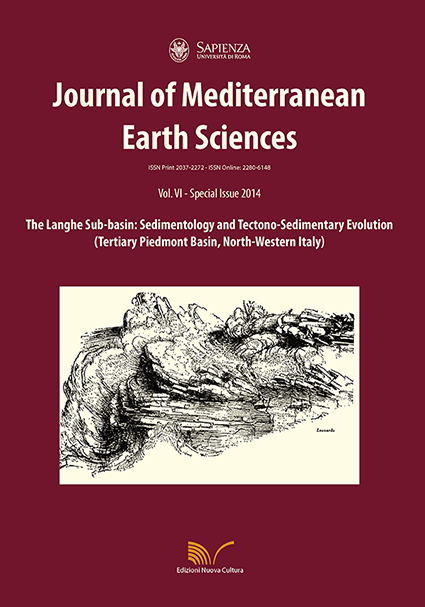Oligo-Miocene tectono-sedimentary evolution of the Tertiary Piedmont Basin southern margin, Roccaverano area-Langhe Sub-basin (NW Italy)
DOI:
https://doi.org/10.3304/JMES.2014.001Keywords:
Tertiary Piedmont Basin, Oligo-Miocene, rocky shore transgression, continental, shelf and slope deposits, extensional tectonics, northern ItalyAbstract
The geologic and paleogeographic evolution of the southern margin of the Tertiary Piedmont Basin (TPB) in the Roccaverano area (Langhe Sub-basin) during the Oligo-Miocene was strongly controlled by synsedimentary tectonics. During the Rupelian, the Langhe Sub-basin in the Roccaverano area was dominated by an extensional tectonic regime, expressed by an intense vertical mobility along high-angle, basement-involving faults with generation of km-scale grabens, accommodating continental conglomerates grading upwards into shelf sandstones (Molare Fm). The Molare continental conglomerates form part of the infill of the Lower Oligocene Borgo and Cartosio grabens, separated by the Spigno Monferrato Horst. A subsequent Rupelian transgression first encroached upon the Borgo Graben (and upon the northern Cartosio Graben) and only later upon the adjacent Spigno Monferrato Horst depositing marine sands directly on the uplifted crystalline basement. Since late Rupelian, inferred transtensional tectonics, mostly following the previous pattern of differentially subsiding blocks, was superimposed on a phase of enhanced regional tectonic subsidence leading to the collapse of the entire southern margin of the TPB, with the onset of deposition of slope to base-of-slope hemipelagic mudstones of the Rocchetta Fm (uppermost Rupelianlower Aquitanian). The most prominent intra-Oligocene structural element of the area is the Spigno Monferrato Horst partly inherited from the former structure, representing the northern end of a complex positive structure (Dego-Spigno Monferrato High) which strongly controlled thickness and facies of the Rocchetta Fm. The Rocchetta Fm is commonly affected by slump scars, the largest of which, about 1 km wide and up to 150 m deep, is located in the Molino di Mombaldone area, and evolved into a submarine canyon/slope valley system. This formation encases several turbidite sandstone bodies of variable dimensions, the largest and youngest of which is the Noceto unit (lower Aquitanian) which most probably represents the infill of a submarine half-graben of pluri-kilometric scale. The Rocchetta Fm is capped by hemipelagic and commonly siliceous sediments, named “Montechiaro d’Acqui Siliceous Lithozone” (middle-upper Aquitanian). This unit represents a regional marker horizon and is interpreted as a condensed section. During the latest Aquitanian-early Burdigalian the fine-grained slope to base-of-slope sedimentation was represented by hemipelagic marls of the Montechiaro d’Acqui Fm. In the lowermost part of this formation resedimented glauconitic sandstones and rhodalgal calcarenites (C. Mevie, Pian Bruno and C. Poggi calcarenites) were deposited, probably derived from coeval foramol-type carbonate platforms. High tectonic mobility in this stage is indicated by the generation of some half-grabens attracting both siliciclastic and carbonate gravity flows. The larger of them is the C. Mazzurini Half-graben, which is infilled with coarse-grained bioclastic sandstones and conglomerates. The middle Burdigalian Serole Fm mainly consists of thinbedded turbidites encasing a number of sandstone bodies. Such deposits are also present as the infill of medium- to large-scale slump scars developed at the top of the underlying Montechiaro d’Acqui marls. Deposition of the Serole Formation started with the infill of an inferred large-scale base-of-slope valley (Piantivello unit) followed by the widespread deposition of thin-bedded turbidites. The large-scale sandy and conglomeratic turbidite bodies of the Rupelian to middle Burdigalian succession were fed from W-WNW, supporting the presence of paleoslopes dipping E-ESE-wards (in the present-day coordinates). By the late Burdigalian the emplacement of volumetrically important, basinal turbidites of the Cortemilia Fm marks a major change in tectonic regime leading to dramatic increase in subsidence rate and accommodation space.
Downloads
Published
How to Cite
Issue
Section
License
The submission has not been previously published, nor is it before another journal for consideration (or an explanation has been provided in Comments to the Editor).


